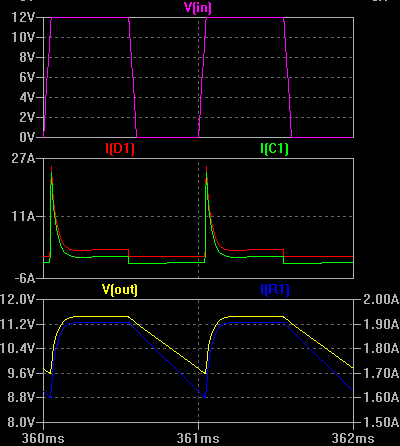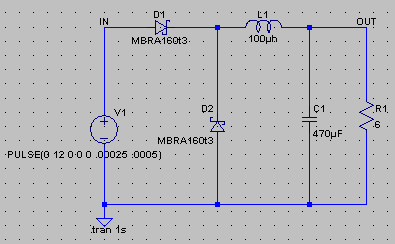Switching Power Supply Fundamentals/The Basic unregulated switching supply
|
The unregulated switching supply
[edit | edit source]The unregulated switching power supply is quite simply a clock turning on and off a switch that is powering a inductor, the output side of the inductor is connected to a capacitor to smooth out the ripple.
|
 |
unregulated output
[edit | edit source]Theory of operation
[edit | edit source]Rather than constantly adjusting the current flow using a transistor or MOSFET like a audio amplifier a SMPS turns off and on the current flow and avoids any partially on state that a linear supply operates in. By avoiding partially on states the switch dissipates a minimal amount of heat. Inductors resist a change in current flow and when the switch is off the inductor current continues flowing and ramps off slowly the diode completes the circuit during this phase. The inductor smooths the pulses of current, just like the capacitor smooths the pulses of voltage.

|

|
|---|---|
|
A SMPS without the inductor. Notice the current flow spikes to 25Amps on the attack edge of the on state. | |
The problem with no inductors
[edit | edit source]
The problem as shown in this picture is a total lack of surge current control. Each turn on all the energy to charge the cap happens at once resulting in a surge of 25 amps. No electrolytic capacitor was made/can be made to handle this kind of repetitive surge current the cap will end up blowing its top or overheating. the switching device MOSFET or BJT will need to be 4 times more powerful than if driving the load directly in linear mode, and it to will undergo some massive stress. Finding a decent sized surface mount diode that handles 25 amps of repetitive peek surge current will be next to impossible and the diode will get hot enough to unsolder its self.
Same circuit with inductor
[edit | edit source]Why regulate
[edit | edit source]With a constant load and a constant or nearly constant supply voltage the output would be fine. But when the input voltage changes or the load changes the output can vary wildly.
|
A unregulated SMPS with a non constant input voltage. | |
|---|---|
| EE230 Edit/View |
|---|
|
* Electronic Engineering * EE Switching Power Supply Fundamentals * The Linear Regulation Problem * The Basic unregulated switching supply * The Basic regulated switching supply |




